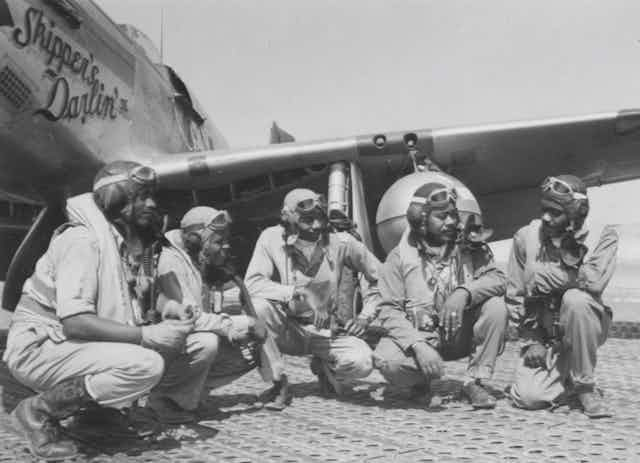New Apple TV series, Masters of the Air, tells the story of the American air effort in Europe during the second world war through the eyes of the Bloody 100th Bomb Group, who were based at Thorpe Abbotts in Norfolk, England.
Viewers have been debating whether its inclusion of black fighter pilots, the famed “Tuskegee Airmen” who served in Italy, is appropriate. As a historian who researches the American air war and the wartime “friendly invasion” of Britain by American troops, I believe a historical perspective can help unpick this contentious issue.
Negative comments have centred on the inclusion of the all-black 99th Fighter Squadron and 332nd Fighter Group who flew in the Mediterranean. This follows the logic that their inclusion is historically inaccurate, as they were not part of the air campaign flown from Britain.
The unpleasant wartime reality for the Tuskegee Airmen was that, in addition to a determined enemy, they had to fight their own side – the US War Department, the US Army Air Force and white commanders – for the right to serve.
Read more: Masters of the Air: Apple's Air Force drama is imperfect, but powerful
Although criticised as “tokenism”, the show’s screenwriter, John Orloff, ensured airtime for these men’s stories in what would otherwise have been an all-white show. He subsequently wrote on Threads that he was “totally baffled by some people’s reaction to the Tuskegee Airmen’s inclusion” and that he was “honored to be a small part of telling their story”.
Black pilots in the US Army Air Force
By the start of 1944, the American air campaign had undergone considerable changes in command structure. Anxious to fend off Allied rivalries, achieve closer coordination and promote the case for an independent US Air Force (it was then part of the army) its chief, General Henry “Hap” Arnold, established the United States Strategic Air Force in Europe (USSTAF).

Based in London and commanded by General Carl A. Spaatz, USSTAF controlled the combined strategic bombing efforts of the Eighth Air Force in Britain (including the 100th Bomb Group) and the Fifteenth Air Force in Italy (including the 332nd Fighter Group).
Although black pilots were prevented from serving directly with the 100th, they were still very much part of a unified American campaign against Germany that transcended geographic boundaries.
Despite this laudable inclusion, Masters of the Air struggles to move beyond the established Tuskegee story that has already been portrayed in other TV shows and films, including The Tuskegee Airmen (1995) and Redtails (2012).
Black stories the show doesn’t tell
Approximately 130,000 African Americans served in Britain during the war with 12,000 supporting the air campaign. In accordance with contemporary US War Department policy, most were relegated to service and supply roles, as Jim Crow segregation laws and discrimination followed them to Britain.
Members of the Combat Support Wing, set up to improve morale following the Bamber Bridge Race Riot of 1943 were responsible for hauling supplies to the airfields, including Thorpe Abbotts. They often faced long hours and the routine refusal of food and accommodation from the “white” bases they serviced.

The 923rd Engineer Aviation Regiment were a unit of approximately 3,200 men tasked with constructing and maintaining the airfields. From late 1942, they performed backbreaking construction shifts to ensure the completion and maintenance of vital airfields. In April to May 1944, approximately 200 men of the 827th Battalion from Regiment worked to repair the runways at Thorpe Abbotts at the very time that some of most dramatic actions of the 100th were taking place.
Masters of the Air is silent on this black experience much closer to home, representing neither the significant contribution of these men, nor the endemic racism they faced. The mythology of the 100th still masks the realities of 1940s American society, despite the available evidence of a substantial black presence at Thorpe Abbotts.
The story of the Tuskegee Airmen is a worthy and inspiring tale of victory over prejudice and Masters of the Air is correct to include them. But its failure to show black soldiers at Thorpe Abbotts allows some of the myths surrounding the Bloody 100th and the wider “friendly invasion” to continue unchallenged.

Looking for something good? Cut through the noise with a carefully curated selection of the latest releases, live events and exhibitions, straight to your inbox every fortnight, on Fridays. Sign up here.

